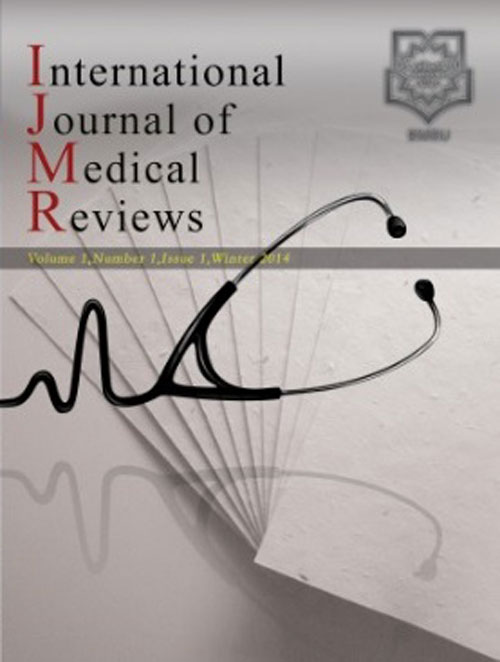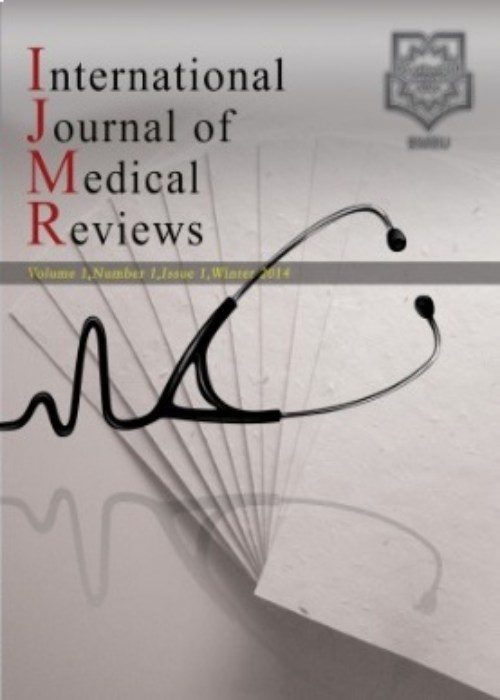فهرست مطالب

International Journal of Medical Reviews
Volume:9 Issue: 2, Spring 2022
- تاریخ انتشار: 1401/04/26
- تعداد عناوین: 7
-
-
Pages 244-253Introduction
Computed Tomography (CT) plays an important role in the diagnosis of diseases and injuries in medicine. The role of CT radiographers is to provide both patient care and high-quality images. This study was aimed at systematically reviewing all available empirical evidence on the experiences of patients with CT examinations to support evidence-based practice in radiography.
MethodsA qualitative research design was used to conduct this review. Five electronic databases including CINAHL,PubMed/MEDLINE, Science Direct, African Journals, and Google Scholar, as well as other relevant sources, were searched for primary studies in October and November 2020. Critical appraisal of the relevant studies was carried out using the Joanna Briggs Institute (JBI) Critical Appraisal checklists. The data were synthesized and analysed thematically.
ResultsA total of 11 studies were identified and included in this review. Three main themes were identified: the before, during, and after experiences of patients with CT. It was clear that pre-knowledge about the CT examination, a warm welcome towards patients, an explanation of the procedure, comfort, a short scan time, empathy, effective communication, and distracting strategies positively affected patients. On the other hand, a long waiting time, fear and anxiety, embarrassment, discomfort and pain for some examinations, and an inadequate explanation of the process involved in obtaining the results negatively affected patients.
ConclusionThe experiences of patients with CT examinations largely depend on their interaction with radiographers. Thisreview findings, which are grounded on evidence, can inform the development of training methods and tools for elicitingfeedback from patients.
Keywords: Computed Tomography (CT), Experiences, Imaging Examination, patients -
Pages 254-262Introduction
Middle ear disease is common in childhood and is often associated with hearing loss. Seventy-one percent of all children have at least an episode of Otitis Media with Effusion (OME) by the age of three. The high incidence of OME in patients with middle ear disease has led to the conclusion that treatment with Tympanostomy Tube Insertion (TTI) would solve the inevitable hearing loss associated with middle ear disease. Studies reporting an association between hearing loss and TTI are conflicting and warrant a systematic review of the evidence.
MethodsA dual review process was used to assess eligible studies drawn from PubMed, Medline via Ovid, and Science direct, reference lists from 2007 to 2018. Five studies were selected.
ResultsThree studies did not specify a primary outcome measure in terms of the types of hearing loss i.e. did not specifically measure CHL and reported benefits in hearing with TTI. The other studies reported incidences of CHL with the use of the TTI.Shorter tubes tended to reduce long term complications. Tube stay-time was on average 6-12 months and required follow up as a result of an increase in complications. The number of insertions was positively correlated with children with symptomatic pathology. Tube location is important as medial displacement can occur as well as not checking tube function. Children aged from zero to six years old benefitted the most from TTI as their hearing loss tended to be the greatest at the baseline compared to older children.
ConclusionAn extensive systematic review identified five studies examining hearing loss and TTI in young children from 2007 to 2018. There are two main findings from this review. First, two studies reported hearing loss in two studies with TTI. Second, the association between hearing loss and TTI may be influenced by the type of hearing loss measure, technical aspects of TTI, and demographic and health characteristics. These findings are strengthened by evidence from a large (n = 3128) globally representative sample of young adults. A proportion of children may experience conductive hearing loss with TTI, and we recommend allied health professionals and general practitioners increase their awareness and understanding of the hearing loss experienced during TTI.
Keywords: Child, Preschool, Middle ear, Hearing loss, Conductive, Tympanostomy Tube Insertion, Myringostomy, Grommet Insertion, Otitis Media, Otitis media with effusion, Nonsuppurative Otitis Media, Technical Aspects, General practitioners, Otorhinolaryngology -
Pages 263-267
Coronavirus disease 2019 (COVID-19) is a contagious and lethal infectious disease with a potential threat to global healthsecurity. Kidney is a multi-organ that has been affected by COVID-19. Angiotensin-Converting Enzyme 2 (ACE2) expression in the different cell populations of kidney including podocytes, proximal tubular cells and so on shows a possible association between renal parenchymal cells involvement and direct Severe Acute Respiratory Syndrome Coronavirus 2 (SARS-CoV-2) invasion to kidney parenchyma at an early stage of disease. Considering the importance of the kidney, this review article highlights the recent findings about the influence of COVID-19 on kidney functions.The main manifestations of the renal complications include proteinuria, elevated plasma creatinine and blood urea nitrogen, hematuria and less frequently, acute tubular injury (ATI) and Acute Kidney Injury (AKI), direct infection of tubular epithelial cells and podocytes, reduced density of kidney, inflammation and edema of the renal parenchyma. The potential pathogenic mechanisms of kidney involvement in COVID-19 patients include direct infection of tubules, dehydration, cytokine-induced systemic inflammatory immune response, organ crosstalk, and drug-induced cytotoxicity.In accordance to clinical manifestations of COVID-19 and the prevalence rate of SARS-CoV-2 in public health, we need to pay more attention to the regularly monitoring of renal function and treatment strategy against the infection of SARSCoV-2 to the renal tissue.
Keywords: Angiotensin-Converting Enzyme 2, ACE-2, COVID-19, Renal function, SARS-CoV-2 -
Pages 268-275
In December 2019, a respiratory disease called Coronavirus Disease 2019 (COVID-19) emerged in Wuhan, China. In thefollowing year, it was considered as a pandemic caused by SARS-CoV-2, an RNA virus belonging to the Coronaviridae family.Asymptomatic patients are the main spreaders of the infection as well as obstacles to control the disease that can progress to death. Currently, it is believed that the Angiotensin-Converting Enzyme 2 (ACE2) acts as a receptor for the penetration of SARSCoV-2 into the human cell. Therefore, this review aims to summarize the variability of the genetic variants of ACE2 with the usceptibility to SARS-CoV-2/COVID-19 in different human populations. In two studies, ACE2 expression in Asians was found to be similar to that of other ethnicities. We observed populations with different variants of ACE2 with single nucleotide polymorphism (dbSNP) that causes inter-individual variability and susceptibility to COVID-19. The dbSNP rs4646116 was found in the Finnish and Latin populations; rs4646127 in Asia, Europe, and the Americas; and rs228566 (c.439+4G>A) was found in South-East Asia (MAF = 0,548%). In Italy, three missense variants of ACE2 (p.(Asn720Asp), p.(Lys26Arg) and p. (Gly211Arg)) interfere with the stabilization of the coronavirus spike protein. Given the studies concerning the genetic variations of ACE2 and SARVS-CoV-2, it is possible to assume the consequences for the pathophysiology of COVID-19, formulate therapies, and develop specific vaccines according to the recognized variants, to reduce the severity and the lethality of the disease in the affected countries.
Keywords: genetic variants, ACE2, SARS-CoV-2, Coronavirus, Human Populations -
Pages 276-282
Even though brain lymphatic system has several peculiarities including the construction of the endothelial cells of the lymph vessels, in common with the lymphatic system of the body in general, studies have documented eminent discrepancy. The unique lymphatic system of the brain is called ‘’the glymphatic system’’ due to its lymphatic system-like function and glial-like fluid flow. The collaboratory functions of this system, and CSF and interstitial fluid has been documented. A recent discovery of this system has highlighted the requirement to review the diagnosis and treatment procedures of several neuronal diseases. With this discovery, anatomic, physiopathologic, immunologic, and genetic natures of this system have attracted attention of scientists. This review has summarized the accumulating information on the lymphatic system of the brain, particularly focusing on the function of the glymphatic system in fetus and newborn, cranial tumors, neurodegenerative diseases, brain metabolism and its relationship with sleep, and the anatomical posture of the body. Yet, the cells responsible with the brain immune system and their relationship with the glymphatic system have been discussed. By summarizing the latest information on the relationship of this system with immunologic, molecular, physiologic, and anatomical aspects of several neuronal diseases, this paper will surely contribute to the diagnosis and treatment of them through shedding light on the researchers.
Keywords: brain, Glymphatic System, Immunity, Neuronal Disease -
Pages 283-287
High-Power Lasers (HPLs) are capable of creating a plume containing tissue debris, vapor, and viruses (HPV, HIV, etc.) which is liberated into the surrounding environment and may have a potential role in infection transmission. The employment of these dental lasers is an equivocal concern during the new Coronavirus Disease 2019 (COVID-19) outbreak. Since many oral tissues are highly potential reservoirs of Severe Acute Respiratory Syndrome Coronavirus 2 (SARS-CoV-2), this study was conducted to scrutinize the possibility of dissemination of this virus through the plume in dental laser treatments during the COVID-19 pandemic. The current evidence shows while the employment of laser is an effective and comfortable tool for dental treatments, it holds some inherent hazards such as producing airborne contaminants. With HPV, HIV, and other viruses already detected in laser plume and considering the presence of ACE2 receptors in the oral cavity, there is a potential risk in laser treatments to produce infectious plume, which may possibly contain SARS-CoV-2. The SARS-CoV-2 virus can potentially be liberated in the plume during dental application of HPLs in suspected or confirmed cases of COVID-19. While the amount of aerosol may be different from other routine dental instruments, this modality should be used with crucial care during the COVID-19 outbreak.In this regard, safety precautions in laser application should be rigorously maintained during the COVID-19 outbreak.
Keywords: COVID-19, SARS-CoV-2, Transmission, Lasers, Virus, Dentistry -
Pages 288-297
Nonsteroidal Anti-Inflammatory Drugs (NSAIDs) are used as analgesics and antipyretics in viral infections, as supportive therapy is the mainstay of treatment. However, their role in the course of the illness is still ambiguous. Several experimental evidences carried out on various viral infections about the role of NSAIDs in the course of illness are contradictory; some reported possible antiviral effects and some negate it. NSAIDs inhibit PGs and also have their own actions on immune system and viruses. NSAIDs have stimulatory effects on T lymphocytes, Nitric Oxide (NO) and interferons, but inhibitory effects on neutrophils, macrophages and antibodies formation. NSAIDs are used as adjunctive treatment in infectious diseases in which cytokines storm plays a role in the pathogenicity. However, in other studies their effects on immune system were associated with unresolved symptoms and complications. The worth saying in this entity is the evidence-based studies of antimicrobial activity of NSAIDs. NSAIDs are proven to inhibit the entry of virus to the cells like in ZIKV, as well as they inhibit the replication of many viruses like the inhibitory effect of naproxen on SARS-CoV-2 replication. However, they fail to show any direct antiviral activity in adenovirus infections, and Ibuprofen increases the shedding of RSV in a bovine model. Indeed, there are many contradictory published studies between various viruses, patients’ cases, and whether it’s a study on animals or humans. More randomized clinical trials are mandatory to exactly elucidate if use of NSAIDs, during viral infections especially COVID-19, modify and abort the course of viral infection by exerting beneficial therapeutic effects or the use of them is accompanied by delirious hazards and negatively impact the health of the patient.
Keywords: antiviral activity, Controversial, COVID-19, Immunomodulatory, NSAIDs, Viral infection


